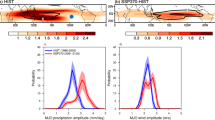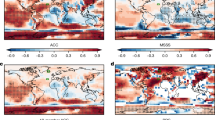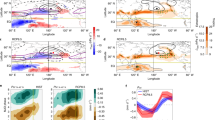Abstract
The Madden–Julian Oscillation (MJO) is a dominant source of subseasonal atmospheric variability in the tropics and significantly impacts global weather and climate predictability. Changes in its activity and predictability due to human-induced global climate change have profound implications for future global weather prediction. Here we investigate changes in MJO predictability in reanalysis and climate model data and find that MJO predictability has increased over the past century. This increase can be attributed to anthropogenic warming and continues during the twenty-first century in projections. The increased predictability is accompanied by stronger MJO amplitude, more regular oscillation patterns and organized eastward propagation under global warming. Our results suggest that greenhouse warming will increase the predictability of the MJO, with far-reaching consequences for global weather prediction.
This is a preview of subscription content, access via your institution
Access options
Access Nature and 54 other Nature Portfolio journals
Get Nature+, our best-value online-access subscription
$29.99 / 30 days
cancel any time
Subscribe to this journal
Receive 12 print issues and online access
$209.00 per year
only $17.42 per issue
Buy this article
- Purchase on Springer Link
- Instant access to full article PDF
Prices may be subject to local taxes which are calculated during checkout





Similar content being viewed by others
Data availability
CERA-20C reanalysis is provided by ECMWF on a data portal (https://apps.ecmwf.int/datasets/data/cera20c/). CESM2 and CESM2–WACCM control run, historical simulations and future projections are accessible through the Coupled Model Intercomparison Project (Phase 6) search interface (https://esgf-node.llnl.gov/search/cmip6/). CSF-20C hindcast ensemble data62 are available via https://catalogue.ceda.ac.uk/uuid/6e1c3df49f644a0f812818080bed5e45 under the Open Government License v.3.0. The MJO RMMI time series we computed in this study has been posted for public access63. Source data are provided with this paper.
Code availability
The Python code used for the WPE computation is available on Zenodo at https://zenodo.org/records/10031057 (ref. 64).
References
Vitart, F., Robertson, A. W. & Anderson, D. L. Subseasonal to seasonal prediction project: bridging the gap between weather and climate. Bull. World Meteorol. Organ. 61, 23 (2012).
Vitart, F. Evolution of ECMWF sub-seasonal forecast skill scores. Q. J. R. Meteorol. Soc. 140, 1889–1899 (2014).
Dai, A. Increasing drought under global warming in observations and models. Nat. Clim. Change 3, 52–58 (2013).
Trenberth, K. E. et al. Global warming and changes in drought. Nat. Clim. Change 4, 17–22 (2014).
Allamano, P., Claps, P. & Laio, F. Global warming increases flood risk in mountainous areas. Geophys. Res. Lett. 36 L24404 (2009).
Min, S.-K., Zhang, X., Zwiers, F. W. & Hegerl, G. C. Human contribution to more-intense precipitation extremes. Nature 470, 378–381 (2011).
Pall, P. et al. Anthropogenic greenhouse gas contribution to flood risk in England and Wales in autumn 2000. Nature 470, 382–385 (2011).
Stott, P. A., Stone, D. A. & Allen, M. R. Human contribution to the European heatwave of 2003. Nature 432, 610–614 (2004).
Dosio, A., Mentaschi, L., Fischer, E. M. & Wyser, K. Extreme heat waves under 1.5 °C and 2 °C global warming. Environ. Res. Lett. 13, 054006 (2018).
Madden, R. A. & Julian, P. R. Detection of a 40–50 day oscillation in the zonal wind in the tropical Pacific. J. Atmos. Sci. 28, 702–708 (1971).
Madden, R. A. & Julian, P. R. Description of global-scale circulation cells in the tropics with a 40–50 day period. J. Atmos. Sci. 29, 1109–1123 (1972).
Waliser, D., Lau, K., Stern, W. & Jones, C. Potential predictability of the Madden–Julian oscillation. Bull. Am. Meteorol. Soc. 84, 33–50 (2003).
Kim, H., Vitart, F. & Waliser, D. E. in MJO Prediction: Current Status and Future Challenges 289–299 (World Scientific, 2020).
Zhang, C. Madden–Julian oscillation: bridging weather and climate. Bull. Am. Meteorol. Soc. 94, 1849–1870 (2013).
McPhaden, M. J. Genesis and evolution of the 1997–98 El Niño. Science 283, 950–954 (1999).
Marshall, A. G., Hendon, H. H., Son, S.-W. & Lim, Y. Impact of the quasi-biennial oscillation on predictability of the Madden–Julian oscillation. Clim. Dyn. 49, 1365–1377 (2017).
Wang, S., Tippett, M. K., Sobel, A. H., Martin, Z. K. & Vitart, F. Impact of the QBO on prediction and predictability of the MJO convection. J.Geophys. Res. Atmos. 124, 11766–11782 (2019).
Vitart, F. & Brown, A. S2s forecasting: towards seamless prediction. WMO Bull. 68, 70–74 (2019).
Bauer, P., Thorpe, A. & Brunet, G. The quiet revolution of numerical weather prediction. Nature 525, 47–55 (2015).
Jones, C. & Carvalho, L. M. Changes in the activity of the Madden–Julian oscillation during 1958–2004. J. Clim. 19, 6353–6370 (2006).
Subramanian, A. et al. The MJO and global warming: a study in CCSM4. Clim. Dyn. 42, 2019–2031 (2014).
Maloney, E. D., Adames, Á. F. & Bui, H. X. Madden–Julian oscillation changes under anthropogenic warming. Nat. Clim. Change 9, 26–33 (2019).
Roxy, M. et al. Twofold expansion of the Indo-Pacific warm pool warps the MJO life cycle. Nature 575, 647–651 (2019).
Wheeler, M. C. & Hendon, H. H. An all-season real-time multivariate MJO index: development of an index for monitoring and prediction. Mon. Weather Rev. 132, 1917–1932 (2004).
Kim, H.-M., Webster, P. J., Toma, V. E. & Kim, D. Predictability and prediction skill of the MJO in two operational forecasting systems. J. Clim. 27, 5364–5378 (2014).
Neena, J., Lee, J. Y., Waliser, D., Wang, B. & Jiang, X. Predictability of the Madden–Julian oscillation in the intraseasonal variability hindcast experiment (ISVHE). J. Clim. 27, 4531–4543 (2014).
Liu, X. et al. MJO prediction using the sub-seasonal to seasonal forecast model of Beijing Climate Center. Clim. Dyn. 48, 3283–3307 (2017).
Zhu, J., Kumar, A. & Wang, W. Dependence of MJO predictability on convective parameterizations. J. Clim. 33, 4739–4750 (2020).
Zhu, J. & Kumar, A. Role of sea surface salinity feedback in MJO predictability: a study with CFSV2. J. Clim. 32, 5745–5759 (2019).
Rashid, H. A., Hendon, H. H., Wheeler, M. C. & Alves, O. Prediction of the Madden–Julian oscillation with the POAMA dynamical prediction system. Clim. Dyn. 36, 649–661 (2011).
Wang, S., Sobel, A. H., Tippett, M. K. & Vitart, F. Prediction and predictability of tropical intraseasonal convection: seasonal dependence and the maritime continent prediction barrier. Clim. Dyn. 52, 6015–6031 (2019).
Kim, H., Richter, J. H. & Martin, Z. Insignificant QBO–MJO prediction skill relationship in the subx and s2s subseasonal reforecasts. J. Geophys. Res. Atmos. 124, 12655–12666 (2019).
Miyakawa, T. et al. Madden–Julian oscillation prediction skill of a new-generation global model demonstrated using a supercomputer. Nat. Commun. 5, 3769 (2014).
Yoo, C., Park, S., Kim, D., Yoon, J.-H. & Kim, H.-M. Boreal winter MJO teleconnection in the Community Atmosphere Model Version 5 with the unified convection parameterization. J. Clim. 28, 8135–8150 (2015).
Laloyaux, P. et al. CERA-20C: a coupled reanalysis of the twentieth century. J. Adv. Model. Earth Syst. 10, 1172–1195 (2018).
Fadlallah, B., Chen, B., Keil, A. & Príncipe, J. Weighted-permutation entropy: a complexity measure for time series incorporating amplitude information. Phys. Rev. E 87, 022911 (2013).
Bandt, C. & Pompe, B. Permutation entropy: a natural complexity measure for time series. Phys. Rev. Lett. 88, 174102 (2002).
Garland, J., James, R. & Bradley, E. Model-free quantification of time-series predictability. Phys. Rev. E 90, 052910 (2014).
Xia, J., Shang, P., Wang, J. & Shi, W. Permutation and weighted-permutation entropy analysis for the complexity of nonlinear time series. Commun. Nonlinear Sci. Numer. Simul. 31, 60–68 (2016).
Yin, Y. & Shang, P. Weighted permutation entropy based on different symbolic approaches for financial time series. Physica A 443, 137–148 (2016).
Pennekamp, F. et al. The intrinsic predictability of ecological time series and its potential to guide forecasting. Ecol. Monogr. 89, e01359 (2019).
Scarpino, S. V. & Petri, G. On the predictability of infectious disease outbreaks. Nat. Commun. 10, 898 (2019).
Garland, J. et al. Anomaly detection in paleoclimate records using permutation entropy. Entropy 20, 931 (2018).
Amigó, J. M., Zambrano, S. & Sanjuán, M. A. Combinatorial detection of determinism in noisy time series. Europhys. Lett. 83, 60005 (2008).
Riedl, M., Müller, A. & Wessel, N. Practical considerations of permutation entropy: a tutorial review. Eur. Phys. J. Spec. Top. 222, 249–262 (2013).
Chowdary, J. et al. Interdecadal variations in ENSO teleconnection to the Indo-Western Pacific for 1870–2007. J. Clim. 25, 1722–1744 (2012).
Danabasoglu, G. et al. The Community Earth System Model Version 2 (CESM2). J. Adv. Model. Earth Syst. 12, e2019MS001916 (2020).
Eyring, V. et al. Overview of the Coupled Model Intercomparison Project Phase 6 (CMIP6) experimental design and organization. Geosci. Model Dev. 9, 1937–1958 (2016).
Latif, M. Dynamics of interdecadal variability in coupled ocean–atmosphere models. J. Clim. 11, 602–624 (1998).
Kiladis, G. N. et al. A comparison of OLR and circulation-based indices for tracking the MJO. Mon. Weather Rev. 142, 1697–1715 (2014).
Le, P. V., Guilloteau, C., Mamalakis, A. & Foufoula-Georgiou, E. Underestimated MJO variability in CMIP6 models. Geophys. Res. Lett. 48, e2020GL092244 (2021).
Cui, J. & Li, T. Changes of MJO propagation characteristics under global warming. Clim. Dyn. 53, 5311–5327 (2019).
Dasgupta, P., Metya, A., Naidu, C., Singh, M. & Roxy, M. Exploring the long-term changes in the Madden–Julian oscillation using machine learning. Sci. Rep. 10, 18567 (2020).
Liu, P. MJO evolution and predictability disclosed by the RMM variant with balanced MJO variance in convection and zonal winds. Clim. Dyn. 52, 2529–2543 (2019).
Arnold, N. P., Branson, M., Kuang, Z., Randall, D. A. & Tziperman, E. MJO intensification with warming in the superparameterized CESM. J. Clim. 28, 2706–2724 (2015).
Wolding, B. O., Maloney, E. D., Henderson, S. & Branson, M. Climate change and the Madden–Julian oscillation: a vertically resolved weak temperature gradient analysis. J. Adv. Model. Earth Syst. 9, 307–331 (2017).
Chang, C.-W. J., Tseng, W.-L., Hsu, H.-H., Keenlyside, N. & Tsuang, B.-J. The Madden–Julian oscillation in a warmer world. Geophys. Res. Lett. 42, 6034–6042 (2015).
Adames, Á. F., Kim, D., Sobel, A. H., Del Genio, A. & Wu, J. Characterization of moist processes associated with changes in the propagation of the MJO with increasing CO2. J. Adv. Model. Earth Syst. 9, 2946–2967 (2017).
Zhou, W., Yang, D., Xie, S.-P. & Ma, J. Amplified Madden–Julian oscillation impacts in the Pacific–North America region. Nat. Clim. Change 10, 654–660 (2020).
Weisheimer, A. et al. Seasonal forecasts of the twentieth century. Bull. Am. Meteorol. Soc. 101, 1413–1426 (2020).
Vitart, F. Monthly forecasting at ECMWF. Mon. Weather Rev. 132, 2761–2779 (2004).
Weisheimer, A. & O’Reilly, C. Initialised Seasonal Forecast of the 20th Century (Centre for Environmental Data Analysis, 2020).
Du, D. et al. Increase in MJO predictability under global warming. Figshare https://doi.org/10.6084/m9.figshare.24082053 (2023).
Du, D. et al. Danni-Du/WPE-computation: code for “Increase in MJO Predictability Under Global Warming”. Zenodo https://doi.org/10.5281/zenodo.10031056 (2023).
Acknowledgements
D.D., W.H. and A.C.S. disclose support from NASA (21-OSST21-0026). D.D. and A.C.S. disclose support from the ONR MISOBOB research initiative (N00014-17-S-B001) and NOAA (NA18OAR4310405). E.B. discloses support from NSF (AGS 2001670). W.H. also acknowledges the travel support of the Johannes Geiss Fellowship from the International Space Science Institute, Bern Switzerland. We also acknowledge high-performance computing support and CESM2 data access from Cheyenne provided by NCAR’s Computational and Information Systems Laboratory, sponsored by the National Science Foundation. All analyses were done with the Casper data analysis and visualization cluster.
Author information
Authors and Affiliations
Contributions
D.D. conducted most of the analyses and drafted the manuscript. All other authors contributed to the discussions on shaping this work, as well as the writing and editing of the manuscript. A.C.S., W.H. and J.B.W. offered suggestions on conceiving and designing the analyses. W.E.C. computed the RMMI in ECMWF seasonal forecasts and in CERA-20C. E.B. suggested using the WPE method and provided mathematical consultants.
Corresponding author
Ethics declarations
Competing interests
The authors declare no competing interests.
Peer review
Peer review information
Nature Climate Change thanks Daehyun Kim, Kai-Chih Tseng and the other, anonymous, reviewer(s) for their contribution to the peer review of this work.
Additional information
Publisher’s note Springer Nature remains neutral with regard to jurisdictional claims in published maps and institutional affiliations.
Extended data
Extended Data Fig. 1 An example MJO diagram.
It shows the MJO trajectory for 1997 January (blue), February (red) and March (black) in CERA-20C (ensemble member m0).
Extended Data Fig. 2 Time series of the MJO predictability in the model outputs represented by WPE.
CESM2 control run (pre-1850; black), CESM2/CESM2-WACCM historical simulation (1850-2015; blue for ensemble mean), and CESM2/CESM2-WACCM ssp585 future projection (2015-2100; red for ensemble mean) are shown. The WPE time series of different ensemble members are shown as the thin colored lines. Note that only the WPE values for the last 100 years in the CESM2 control run are plotted. Though these values are plotted as pre-1850 on the time axis, they are actually the results of a free model run initialized from conditions of Year 1850, and do not correspond to any calendar years.
Extended Data Fig. 3 The budget analysis of WPE.
It visualizes how individual permutations contribute to the WPE changing rate of RMM1, RMM2, the MJO amplitude and the MJO propagation in ssp585 runs. The unit of the y-axis values is year−1.
Supplementary information
Supplementary Information
Supplementary Sections 1–4 with Figs. 1–19.
Source data
Source Data Fig. 1
Statistical source data.
Source Data Fig. 2
Statistical source data.
Source Data Fig. 3
Statistical source data.
Source Data Fig. 4
Statistical source data.
Source Data Fig. 5
Statistical source data.
Source Data Extended Data Fig. 1
Statistical source data.
Source Data Extended Data Fig. 2
Statistical source data.
Source Data Extended Data Fig. 3
Statistical source data.
Rights and permissions
Springer Nature or its licensor (e.g. a society or other partner) holds exclusive rights to this article under a publishing agreement with the author(s) or other rightsholder(s); author self-archiving of the accepted manuscript version of this article is solely governed by the terms of such publishing agreement and applicable law.
About this article
Cite this article
Du, D., Subramanian, A.C., Han, W. et al. Increase in MJO predictability under global warming. Nat. Clim. Chang. 14, 68–74 (2024). https://doi.org/10.1038/s41558-023-01885-0
Received:
Accepted:
Published:
Issue Date:
DOI: https://doi.org/10.1038/s41558-023-01885-0
This article is cited by
-
MJO’s predictability on the rise
Nature Climate Change (2024)



